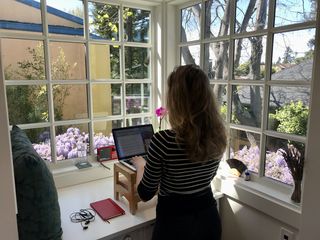
Productivity
Working from Home: How to Optimize Productivity and Well-Being
Using the BALANCED checklist to create an effective homeworking space.
Posted April 1, 2020 Reviewed by Gary Drevitch

New evidence reveals ninja attacks are on the rise for unsuspecting homeworkers during the COVID-19 lockdown!
OK, yes, it’s April Fools Day. But a quick peek at #WFH tweets will confirm that new work-from-homers are facing an onslaught of metaphorical ninja distraction attacks, ranging from playful pets to mind-numbing spells of boredom.
While working from home (WFH) has been on the rise for decades, only 5 percent of U.S. workers reported full-time WFH before the COVID-19 outbreak. Even if we worked at our kitchen table part-time before, most of us are woefully underprepared to optimize our new situation.
A 2019 study of over 2,000 remote workers found that many struggle with loneliness, distraction, and unplugging after work—all posing major obstacles to productivity and wellness.

But fear not, new homeworkers: In my past decade of self-employment, I’ve had time to explore the many perks and pitfalls of working from home.
Many of the challenges we face working under our own roofs are a result of over- or under-stimulation: Too much noise from your cooped-up children playing pirates, for example. Or too little acoustic and social stimulation because you’ve been trapped all alone. With a few simple tools, however, WFH can actually promote great focus and work-life balance.
I’ve put together a tool I call the BALANCEDSM Checklist, which you (and your employees, family members, and coworkers) can use to assess and improve your home working environments—all backed up by environmental psychology evidence. I’ve used this checklist in settings ranging from workspaces and homes to prisons. I call it the BALANCED Checklist because it helps people learn how to balance factors such as lighting, layout, acoustics, temperature, and nature-based features to make any workspace a better place to think, heal, and create. And also, of course, because it forms a handy acronym: Biophilia, Atmosphere, Layout, Amenities, Noise, Cohesion, Energy, & Design. So here are a few practical steps you can take.

Biophilia. Workspaces featuring plants and natural materials can reduce blood pressure and increase attentiveness and reaction time by up to 12 percent. Go on a little hunt around your home and garden and see what treasures you can collect to bring some of these biophilic benefits into your home workspace. My treasure hunt turned up this beloved orchid and a wooly lambskin, but an old seashell collection or postcards from beautiful beaches or mountains could work too.
Atmosphere. Looking on the bright side, you may have more control over atmospheric factors—including lighting, temperature, and air quality and flow—at home than in a shared workspace. Research has shown that we prefer natural ventilation to the highly-processed air and static temperature conditions produced by office HVAC systems. Variability in airflow and temperature – more similar to natural conditions – has been linked to greater well-being, concentration, and comfort. Open the window or door to let some fresh air in. Even a fan in another room can help promote healthy fluctuation in airflow and temperature.

Layout. Workers with a good view outdoors have been found to perform up to 25 percent better as measured by mental function and memory recall than those without windows (as I covered in a previous post). So please, optimize your ninja-proof seating accordingly. It may actually be easier to find a spot in your home where you can simultaneously have your back to the wall and a window view than it is in many offices. Positioning your work station with an easy outdoor vista, either to nature or to street activity, provides microdoses of restorative and stimulating views, more important now than ever. And remember: These ninja-proof seats may be found in unsuspected spots. Who would guess a laundry room folding table could transform into the perfect sit/stand desk.
Amenities. For optimal well-being, workspaces should also provide amenities to support healthy nutrition, physical activity, and rest. Lucky for you, your home is already most likely equipped with a bed and dining facilities. But when working from home, this means not working in bed, as tempting as we all know that is. Try to define a clear area as your workspace—and keep it distinct from where you sleep and eat—even if that means setting up your workstation on the opposite side of the kitchen table, and clearing work materials away before dinner.
Stay tuned for the rest of the checklist – Noise, Cohesion, Energy, and Design – in an upcoming post.
References
Lohr, V. I., Pearson-Mims C. H., and Goodwin, G. K. (1996). Interior Plants May Improve Worker Productivity and Reduce Stress in a Windowless Environment. Journal of Environmental Horticulture, 14 (2), 97-100.
Kaplan, R. and Kaplan, S. (1989). The Experience of Nature: A Psychological Perspective. Cambridge: Cambridge University Press.
Heschong, L. (2003). Windows and Offices: A Study of Office Worker Performance and the Indoor Environment. California: California Energy Commission.

